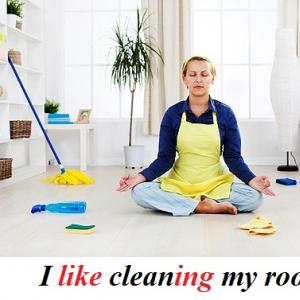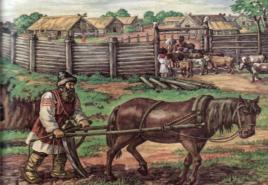Italian language, Italy, independent study of the Italian language. Santa Maria delle Grazie - an example of the Renaissance Santa Maria delle Grazie
This site is dedicated to self-learning Italian from scratch. We will try to make it the most interesting and useful for everyone who is interested in this beautiful language and, of course, Italy itself.Interesting about the Italian language.
History, facts, modernity.
Let's start with a few words about the modern status of the language; it is obvious that Italian is the official language in Italy, the Vatican (simultaneously with Latin), in San Marino, but also in Switzerland (in its Italian part, the canton of Ticino) and in Several districts in Croatia and Slovenia, where a large Italian-speaking population lives, Italian is also spoken by some of the residents on the island of Malta.
Italian dialects - will we understand each other?
In Italy itself, even today you can hear many dialects, sometimes it is enough to travel only a few tens of kilometers to encounter another of them.Moreover, dialects are often so different from each other that they can seem like completely different languages. If people from, for example, the northern and central Italian “outback” meet, they may not even be able to understand each other.
What is especially interesting is that some dialects, in addition to the oral form, also have a written form, such as the Neopolitan, Venetian, Milanese and Sicilian dialects.
The latter exists, accordingly, on the island of Sicily and is so different from other dialects that some researchers distinguish it as a separate Sardinian language.
However, in everyday communication and, especially, in large cities, you are unlikely to experience any inconvenience, because... Today, dialects are spoken mainly by older people in rural areas, while young people use the correct literary language, which unites all Italians, the language of radio and, of course, television.
It may be mentioned here that until the end of the Second World War, modern Italian was only a written language, used by the ruling class, scientists and in administrative institutions, and it was television that played a big role in the spread of the common Italian language among all inhabitants.
How it all began, origins
The history of the formation of modern Italian, as we all know it, is closely connected with the history of Italy and, of course, no less fascinating.Origins - in Ancient Rome, everything was in the Roman language, commonly known as Latin, which at that time was the official state language of the Roman Empire. Later, from Latin, in fact, the Italian language and many other European languages arose.
Therefore, knowing Latin, you can understand what a Spaniard is saying, plus or minus a Portuguese, and you can even understand part of the speech of an Englishman or a Frenchman.
In 476, the last Roman emperor, Romulus Augustulus, abdicated the throne after the capture of Rome by the German leader Odocar, this date is considered the end of the Great Roman Empire.
Some also call it the end of the “Roman language”, however, even today disputes still rage as to why exactly the Latin language lost its relevance, because of the capture of the Roman Empire by barbarians or was it a natural process and in what language? spoken towards the end of the Roman Empire.
According to one version, in ancient Rome by this time, along with Latin, the spoken language was already widespread, and it is from this popular language of Rome that the Italian that we know as Italian of the 16th century comes from, according to the second version, in connection with the invasion of the barbarians Latin mixed with various barbarian languages and dialects, and it is from this synthesis that the Italian language originates.
Birthday - first mention
The year 960 is considered the birthday of the Italian language. This date is associated with the first document where this “proto-vernacular language” is present - vulgare, these are court papers related to the land litigation of the Benedictine Abbey, witnesses used this particular version of the language so that the testimony would be understandable to as many people as possible, until this moment in all official papers we can only see Latin.And then there was a gradual spread in the ubiquitous life of the language vulgare, which translates as the people's language, which became the prototype of the modern Italian language.
However, the story does not end there, but only becomes more interesting and the next stage is associated with the Renaissance and with such well-known names as Dante Alighiere, F. Petrarch, G. Boccaccio and others.
to be continued...
On line translator
I suggest that all guests of my blog use a convenient and free Italian online translator.If you need to translate a couple of words or a short phrase from Russian to Italian or vice versa, you can use the little translator on the sidebar of the blog.
If you want to translate large text or need other languages, use the full version of the online dictionary, where there are more than 40 languages on a separate blog page - /p/onlain-perevodchik.html
Italian language tutorial
I present a new separate section for all students of the Italian language - Italian language self-instruction manual for beginners.Making a blog into a full-fledged Italian tutorial is, of course, not easy, but I try to give the most convenient and logical sequence of interesting online lessons so that you can learn Italian on your own.
There will also be a section - an audio tutorial, where, as you might guess, there will be lessons with audio applications that can be downloaded or listened to directly on the site.
How to choose an Italian language tutorial, where to download it, or how to study it online, you will find information about this in my posts.
By the way, if anyone has ideas or suggestions on how best to organize such a tutorial on our Italian blog, be sure to write to me.
Italian on Skype
Secrets of how you can learn Italian on Skype for free, whether you always need a native speaker, how to choose a teacher, how much it costs to learn Italian via Skype, how not to waste your time and money - read about all this in the section “Italian language on Skype.”Come in, read and make the right choice!
Italian phrasebook
Free, Fun, with a native speaker - a section for those who want to learn words and phrases on certain topics.Join, listen, read, learn - voiced Italian phrasebook for tourists, shopping, airport, everyday situations and much more
In chapter "
Photo: Church of Santa Maria delle Grazie
Photo and description
Santa Maria delle Grazie is a church and Dominican monastery in Milan, listed as a UNESCO World Heritage Site. The main attraction of the church is Leonardo da Vinci's painting "The Last Supper", painted on the wall of the monastery dining room.
The construction of the Dominican monastery and church was begun by order of the Duke of Milan, Francesco Sforza I, on the site where a small church dedicated to Our Lady of Mercy had previously stood. Guiniforte Solari was appointed as the architect. In 1469, the construction of the monastery was completed, but the church was still under construction for some time. The new Duke, Ludovico Sforza, decided that the church should become the tomb of the Sforza family and ordered the cloister and apse to be rebuilt - the work was completed after 1490. In 1497, Ludovico's wife Beatrice was buried here.
It is believed that Donato Bramante worked on the design of the church apse, although there is no reliable evidence of this. However, his name is carved on a small piece of marble on the temple vaults, the inscription dates back to 1494.
In 1543, the Chapel of the Holy Cross on the right side of the nave was decorated with Titian’s painting “The Laying of the Crown of Thorns,” which is now kept in the Louvre in Paris (removed by Napoleon’s troops at the end of the 18th century). This chapel is also decorated with frescoes by Gaudenzio Ferrari. And in the small cloister, located next to the door to the sacristy, you can see a fresco by Bramantino. Another attraction of the church are the frescoes by Bernardo Zenale.
But, of course, the main treasure of Santa Maria delle Grazie is the world famous painting “The Last Supper” by Leonardo da Vinci. It was painted in 1495-98 and depicts the scene of the last supper of Jesus Christ with his disciples. During the Second World War, on the night of August 15, 1943, bombs dropped by British and American troops destroyed the church and monastery building. Most of the refectory was in ruins, but some walls miraculously survived, including the one depicting Da Vinci's Last Supper. From 1978 to 1999, a large-scale restoration of the painting was carried out, which made it possible to preserve it for posterity.
The Church of Santa Maria delle Grazie, belonging to a Dominican monastery, is located in one of the western districts of Milan, and is rightfully considered one of the most beautiful churches of the Renaissance.
History of construction
 The small church in the late Gothic style was built in the 15th century. It all started with in 1463 Count of Vimercati, engaged in philanthropy, donated a plot of land to the Dominican monastic order, on which it was decided to build a church.
The small church in the late Gothic style was built in the 15th century. It all started with in 1463 Count of Vimercati, engaged in philanthropy, donated a plot of land to the Dominican monastic order, on which it was decided to build a church.
Construction, which began in 1469 by order of the Dominican monks, was carried out under the direction of Giniforte Solari. But at the final stage of construction, Duke Ludovico Sforza suddenly intervened in the work, who decided to turn the church into a personal tomb. For this purpose, the architect Donato Bramante was urgently summoned, who had the honor of completing the construction.
Bramante modified the original architecture, rebuilding the dome of the temple and the choirs inside the premises, and also making a cube with three apses instead of a semicircular apse. A portico with columns was attached to it, and the gateway medallion depicts Ludovico himself and his wife (the work of Leonardo da Vinci). All the splendor is crowned by a huge dome. The coat of arms of the Sforza family is depicted on the brick wall of the façade.
The church was built of red brick, and the façade was lined with small slabs of light marble. The high ceiling is formed by nave ceilings. Famous Lombard masters took part in painting the walls with frescoes.– Donato Montorfano (he owns a work called “The Crucifixion”), Gaudenzo Ferrari (a series of frescoes on the theme of the life of Jesus Christ). To the left of the entrance is the della Crochia Chapel.
Bramante also came up with the idea of a courtyard: usually the courtyard of churches of the Early Renaissance was distinguished by gloom and enclosed space, but Bramante built a bright, spacious courtyard with a small pool in the middle.

This courtyard also has its own secret. Walking through a small gallery to the ancient sacristy, you can find a hidden underground passage that connects the premises of Santa Maria delle Grazie and the Duke of Sforza Castle.
Despite the fact that Sforza eventually lost his leading position and influence, work on the construction and decoration of the church did not stop. A little later, the Court of the Inquisition settled here, and work on decorating the church continued with redoubled zeal - the walls and ceilings were painted with scenes from biblical life. Repair work lasted until the end of the 17th century.

In 1980, the monastic complex of Santa Maria delle Grazie (monastery and church) was included in the UN World Heritage List.
“The Last Supper” by Leonardo da Vinci: description and photo of the painting
The main attraction of the church in Milan is famous fresco by Leonardo da Vinci - “The Last Supper”, more precisely, the painting can be seen not in the church itself, but in the refectory, located to the left of the central entrance, on the far end wall. The dimensions of the fresco are 8.8 by 4.6 meters.
Leonardo's idea was to give the monks the impression that Jesus and his disciples were eating with them, practically at the same table. The figures on the fresco are depicted in full height, and it seemed to everyone entering the refectory that Jesus was really eating the food with everyone at the common table.

For a long time, Leonardo could not find a model for the image of Judas, and as a result, the prototype was the abbot of a Dominican monastery, who greatly bothered the artist during his work. The images of the students were copied from ordinary townspeople whom Leonardo looked for in taverns, on the streets and in the monastery.
The fact that the fresco survived the bombings of World War II is considered by many to be a miracle. The documents preserved data that the neighboring wall was demolished by the explosion, but the wall with the fresco itself remained almost undamaged.
"Last Supper" restored 7 times, the last restoration lasted for 20 years and was completed in 1999. Before the last restoration, church workers discovered that the wall on which the fresco is located was beginning to become damp, posing a threat to the masterpiece.
It was decided to remove the top layers of plaster along with the fresco and dry it using special technologies. During the last restoration, all previously applied paints and low-quality additions were removed from the fresco, and the masterpiece appeared to the world almost in its original form.
Today, people are allowed to see the fresco only after a mandatory procedure - visitors will need to go through a special machine that will remove as much dirt and dust as possible. This is done to ensure that as little damage as possible is caused to Leonardo’s creation.
Those who, for a number of reasons, were unable to admire the masterpiece while visiting church should not be upset - in the church courtyard on one of the walls there is a skillfully executed copy of the fresco.
Learn more about the church and the mysteries and secrets of Leonardo da Vinci's painting "The Last Supper" from the video:
Do you want to visit the surrounding area of the city, but don’t know what to see near Milan? !
Address: Piazza di Santa Maria delle Grazie, 20123 Milano, Italy. Opening hours: daily from 07:00 to 19:00 (break from 12:00 to 15:00); To visit the hall with the "Last Supper" a preliminary registration is required; groups of 25 people are formed every 15 minutes. The cost of visiting is 14 EUR. How to get there: the church is located between the metro stations "Conciliazione" and "Cadorna" (line M-1).
Santa Maria delle Grazie - guardian of the Last Supper by Leonardo da Vinci
Geniuses don't die! Leaving the body, a piece of the soul continues to live in their immortal masterpieces. Leonardo da Vinci is a secret behind seven seals, the most mysterious person in the centuries-old history of mankind. He was idolized and hated, considered an angel and a demon, not understood, but could not help but admire him. To this day they travel, fly, hurry to Milan millions of people want to stand in an incredible line outside the church Santa Maria delle Grazie dreaming of seeing "Last Supper"- a unique brainchild of the famous artist, who immortalized the worst betrayal on Earth and the manifestation of boundless love.
The birth of a monastery of peace and tranquility
It all started with a plot of land located in a quiet area, far from the busy, bustling capital of Lombardy. It was presented to the Order of Dominican friars by Count Vimercati (1463). The brothers in faith decided to build a monastery there with a church named after the miraculous icon of the Mother of God “Merciful”. The famous architect Guiniforte Solari, who was involved in the construction of the Duomo Cathedral, undertook to bring the plan into reality. By 1469, monastic dwellings had grown and construction of a basilica in the late Gothic style began, but it was not completed. What was the reason? The financial philanthropist was known as the despotic Lodovico Sforza, at the top of the power pyramid, nicknamed Moro for his dark skin color, who gained power after the death of his nephew, which occurred under rather mysterious, incomprehensible circumstances. What are the motives for generous charity? He believed that by helping the monks he would shorten his time in purgatory by leaving the mortal world. But the ruler wanted to see art that reflected his power. To implement his artistic plans, he chose the monastery sanctuary. There is another version: having married 15-year-old Beatrice d’Este (1491), the ruler got the idea to build a family tomb there. Perestroika was entrusted to Bramante (1492). The decoration of the church interior was entrusted to the best painters and sculptors. The result is a three-nave red brick temple 63 m long, 30 m wide, representing a cross of regular shape at the base. Light streams penetrate through multiple alternating round, arched windows decorated with light marble. Part of the previous structure was demolished and a huge cube with three apses was added. A portico with Corinthian columns harmoniously fits into the building, and on the façade is the coat of arms of the Sforza family. The stepped building is crowned, as if floating above it, by a painted dome, located opposite the sacristy with lace ornaments. There is a medallion above the entrance gate. It shows the Virgin Mary surrounded by the ducal couple. The lack of gigantic dimensions does not make the building any less majestic. In front of enthusiastic visitors is a real pearl in the service of paradise. The wall paintings were carried out by popular local masters of painting. Here are the amazing works of Donato Montorfano, Bernardo Zenale, Gaudenzio Ferrari, depicting the life episodes of the Savior. A small piece of marble on the vaults preserves the Bramante family name. Moreau ordered the completely rebuilt refectory to be decorated by Leonardo, thereby immortalizing his own name. The ruler was in a hurry, constantly urging the architect, working like a man possessed, as if he was afraid of not being on time, reminiscent of a man who was given little time by fate. And so it happened. It took no more than a year to admire the achievements. Misfortunes arose with the death of his wife. Finding her husband with his mistress, a 22-year-old pregnant woman, killed by betrayal, went to pray in the chapel, then visited the refectory, where the brilliant Florentine worked hard, standing on scaffolding. She silently enjoyed the work, recognizing it as a miracle. As she left, she said that she had dreamed of waiting until it was completed, but apparently it wasn’t meant to be. The maestro tried to object, but covering his mouth with her graceful fingers, she sadly whispered: “God bless you!” A monstrous premonition crept into the creator’s heart, which did not deceive him. That same evening, in the presence of her husband, who was tormented by remorse after giving birth to a stillborn baby, the poor thing died. For a widowed man, the sudden loss that took him by surprise was extremely difficult. I thought he would not survive the grief that befell him. “We don’t keep what we have; when we lose it, we cry,” says the proverb.
Awareness, as a rule, comes too late. Experiencing inhuman torment, Moreau realized: the young, flame-like fragile princess, almost a child, keen on literature and art, was endowed with a strong character, a sharp mind, turned out to be much stronger than him, played an important role in government affairs. Loving in his own way, he considered her a guiding star. When she looked lovingly, slightly half-mockingly, a desire was born to lightly spank the playful dark-skinned woman and immediately kiss her, but this did not stop her from having favorites, although she suspected insane jealousy. They buried her in the church before the altar. He spent two weeks as a recluse, covering his windows with mourning cloth. Putting on a black cloak, he rushed to the grave every day. Being superstitious, I had no doubt that my beloved took away good luck with her. And so it happened. The power, which until recently had been held so tightly, flowed away like sea sand through the fingers, dissolving like a mirage. In 1499, the city was captured by the French, and Sforza was taken prisoner. Two years later, Louis XII, showing mercy, ordered the prisoner to be released from prison. When the prison gates opened before him, his worn-out body could no longer be helped. Stretching out his hands to the light, as if wanting to embrace the expanse bathed in the sun, as if knocked down, collapsing to the ground, he died. Their common tomb with Beatrice with two recumbent full-length statues was placed in the Carthusian monastery of Pavia (made by Cristoforo Solari). Santa Maria did not become a family pantheon, as planned, but it preserved for descendants the rarest marvel of the titan of Renaissance painting, which no one managed to surpass.
Creation of a legendary fresco
Da Vinci, an illegitimate child, failed to receive a decent education. At the age of 14, the boy, talented since childhood, came to Florence and became an apprentice to the wonderful sculptor and artist Andrea Verrocchio, who introduced him to religious art. The mentor, who was more often interested in sculpture, did not teach the young man how to paint walls. Having established himself as an excellent portrait painter, surpassing even Verrocchio, he basked in the rays of fame. The responsible order received from Lodovico could lift it to unprecedented heights or destroy it. For 2 years, the craftsman prepared to reproduce the psychological plot, which must coincide with the evangelical text, conveying a reliably true tragedy that once happened. He thought for a long time, studied the Bible, and became acquainted with similar paintings made 100 years before him. The image had to correspond to a long-standing strict tradition: believers eating food were placed on one side of the table, unquestioningly observing deathly silence. Finally, work began to boil. First, helpers removed the old plaster and replaced it with fresh plaster. The fresco was painted on a damp base, then it was preserved for centuries. The innovator wanted to use a hitherto unknown method, using oil paints. To do this, a different primer was applied, consisting of different layers. The first, for the binder, contained calcium and magnesium. The next one, with lead white, is to enhance brightness. He preferred to write on a dry surface so that he could create slowly, thinking about every detail. Sometimes he didn’t let go of his brush from early morning until late at night, sometimes he stood still for hours at his creation, thinking, appraising, or, after adding a couple of strokes, he disappeared, not appearing for several days. This went on for 3 years. The image of Judas especially did not work out, although he was constantly looking for it, wandering through the seedy streets, looking closely, noticing, memorizing. From dawn to dusk he followed the Milanese, who attracted attention with their unusual manners, distinctive appearance, and strange habits. Pope Leo X sarcastically threw at him: “He will never do anything, because he thinks about the end without starting at the beginning.” When, after the abbot’s complaint, the customer made a claim, the maestro, in a fit of anger, threatened that he would paint the apostate from him, after which they stopped harassing him. As a result, he found a solution to the problem, refusing to present the traitor as a notorious villain. He showed a philosopher who was in the deepest spiritual crisis, condemned to play out an ill-fated role that disgraced him forever. And now the long creative process is completed. The final touches were applied, the auxiliary structures were removed, and for the first time the completed titanic work appeared in all its splendor to the large audience that filled the workshop to capacity.
The original appearance of the work
What was revealed to the viewer's gaze defied any description. The painting of gigantic dimensions (4.5 x 9 m) occupying the northern wall of the dining room, depicting the last Easter meal of Jesus with the apostles on the eve of his arrest by Roman soldiers, was perfection itself, unlike any decoration. Looking at her, there was a feeling that a dramatic event from Holy Scripture was happening right here and now. What was especially striking was the illusion of the space existing behind those sitting, making one feel literally inside it, to feel like a participant in the drama taking place. The power of influence on those present was simply stunning. No one before, or after, managed to achieve such high skill. The acting characters are turned towards the audience. The main ones are the Teacher, located in the center, and the student who betrayed him. Their similarity is that both know what will happen, but do not change the situation. The author depicted the main point - the reaction of each character to the words spoken by the Lord: “One of you will betray me.” What they heard caused confusion, causing various emotions among followers, as evidenced by facial expressions and gestures. Christ is calm, ready to bear a heavy cross with dignity for the sake of atonement for the sins of others. He sits against the background of a window, behind which the landscape and space are transformed into a halo that does not yet exist. The eyes look down, the left hand is laid palm up, signifying the internal acceptance of the will of the Heavenly Father. On the right is a trio of supporters, among whom is Judas, not separated from the rest, only the darkened face betrays a fallen soul, marked by the Fall. He clutches a bag of silver pieces to his chest, which turned out to be more valuable than the Son of God. He knocks over the salt shaker - a sure sign of trouble. By the elongated neck and swollen veins, one can guess the sinner who hanged himself before dawn. Peter, standing up, determined to find out the name of the traitor, clamped his knife, preparing to punish the criminal. The daredevil will cut off the ear of the guard who came to arrest the Creator. John’s humble appearance and closed eyelids hint at his inability to take active action. Da Vinci sought to express the spiritual essence of everyone through movements. Groups of people, layering on top of each other, heat up passions and create a contrast between the emotional response of the diners. Here is Thomas, pointing his finger to the heavens, as if saying: “The Almighty will not allow this.” Nearby - Philip, clasping his hands together, demonstrates immeasurable devotion; Simon parted them in bewilderment, expressing doubt: “This cannot be.” The volume of the figures makes a great impression; they are perceived as alive. On the opposite side is the crucifixion scene (created by Tintoretto), which serves as a continuation of the biblical story. After all, the crime led to execution. If the Lord had raised his saddened gaze, he would have seen himself crucified the next day. There was no talent on the planet who could so convincingly convey the fact described in the Gospel. The delightful creation, which brought the creator an enchanting triumph, was not signed by him. At the top there is a personal coat of arms, the initials of the customer. The French king, who saw the jewel, was so amazed that he asked to transport it along with the partition to France, which was impossible. She became an integral part of the destined place, which was an advantage and at the same time a tragedy.
The vicissitudes of the planid
Unfortunately, the priceless treasure was doomed from the moment it appeared. Only ideal conditions would have saved his life, but the foundation of the building, standing on high groundwater, was being washed away. Evaporation from the kitchen that penetrated inside accumulated, contained by an oil film, causing fungus. The paint peeled off like petals and fell off. The experiment tried by the great inventor failed miserably. Having returned, he tried in every possible way to restore and save the precious unique piece, but could not find a way to stop the ongoing process of decay. The exclusive creation slowly died, being in a deplorable state, as noted a century later by the English memoirist John Everin, who observed it. The monks, considering it hopelessly corrupt, widened the door below, destroying the fragment with the Lord’s feet. Soon the picture became covered with mold, and water dripped down like tears onto the floor. In the 18th century The human destructive factor has been added to the natural damage. Napoleon, who captured Milan, built a stable and warehouse here. Rough soldiers, incapable of appreciating the beautiful, went on rampages, threw stones, scratched out the eyes of the holy messengers with daggers, and mutilated the clothes that were painted with such love. Only Bonaparte's intervention stopped the outrage. The doorway was blocked with bricks. The walled up fresco has practically disappeared. Illiterate restorers caused significant damage by applying paint in layers like layers of a layer cake, gluing crumbling pieces together with thick glue, smoothing the surface with hot rollers, and distorting the face beyond recognition with inept retouching of the face. The Second World War brought painful trials. During the bombing, the canteen was destroyed by a bomb that hit it. Apparently, from above they did not allow the painting to disappear. The wall with it survived. Without a roof over her head, blown by the winds, drenched by rain, she heroically survived for three years.
Revived through the centuries
The painting managed to reach us, passing through centuries, suffering, earning the right to life, given to it by a group of restorers led by Signora Pinin Brambilla Barchilon. Experienced specialists restored slowly, 21 years, adhering to the motto “do no harm.” The primary task is to stop further destruction, then remove multiple layers of different time periods, leaving only the created maestro. It happened that in a day they cleared an area the size of a postage stamp. As a result, only 30% of the prototype remained. We decided to re-paint fragments that could not be restored, using watercolors in more muted tones, in order to allow viewers to distinguish parts of the original. We developed a complex system of a stable microclimate in the hall, providing proper ventilation and thorough air filtration to remove excess moisture and dust. On May 28, 1999, the masterpiece was reopened for viewing. After the publication of “The Da Vinci Code,” composed by Dan Brown, which sold about 10 million copies, the master’s phenomenal work became the center of attention of pilgrims from all over the world. The novel was read by many readers, much more than those who became personally acquainted with the painting, a distorted interpretation of the writer, which exploded the Christian tradition. The bestselling author speaks out about the mysterious meaning supposedly implied by the artist who depicted Mary Magdalene instead of his beloved student. Between her and the God-man, the modernist spotted the encrypted Latin letter “V”, speaking of the feminine principle. Together, both figures represent the letter “M”, indicating Christ’s companion, in fact, his wife. Many believed the postmodernist’s conclusion, historians unanimously categorically rejected it. Where then did the 12th apostle disappear to? Every day the painter’s work was observed by the monastery prior, who did not allow the slightest deviation from the interpretations of the New Testament. And lastly: the absolute identity of the combined faces of John and the Madonna is proof that they are based on a single portrait sketch. And if there was any secret, Leonardo took it with him forever into eternity. Entering here, visitors are allowed to examine, admire, and compare the copies imprinted in memory with the original in just 15 allotted minutes. Dying a painful death, resurrected today, transformed, "The Last Supper", being nothing more than a memory of past greatness, again tells those who are thirsty the ancient story of Holy Scripture, once again putting humanity before a choice: to live with God in the soul or to follow the path of lies and hatred , betrayal.
The Church of Santa Maria delle Grazie, located in the heart of Milan, a significant architectural monument and one of the symbols of the Catholic faith, is inextricably linked with Leonardo da Vinci's fresco of the Last Supper, painted on the wall of its refectory.
The church was included in the World Heritage List in 1980 as one of the finest examples of Renaissance art, the significance of which is emphasized by the exceptional work of da Vinci, an outstanding representative of the creative genius of man. Milan, a crossroads of important political social and economic events, played a decisive role in the affairs of the entire peninsula. Here, in 1460, Count Gaspare Vimercati, commander of Francesco Sforza's militia, gave the Dominicans a chapel with a fresco depicting Our Lady, nicknamed "Merciful" (delle grace), then a church and monastery of the same name were built.
Work began in 1463 according to the design and direction of Guiniforte Solari: the construction of the monastery was completed in 1469, and the opening of the church took place only in 1482.
Later, on the orders of Ludovico Moro, who intended to use it as a family tomb, the church was rebuilt.
This reconstruction is attributed to Bramante, during which a magnificent vast space was created, large semicircular apses were added, a majestic dome resting on a belt of rectangular columns, an amazingly beautiful courtyard and a refectory.
The superb architecture of the church and Leonardo's Last Supper in the refectory became true symbols of Renaissance Milan, ushering in a new era in the history of European art.
Along the side walls of the church are seven square chapels on each side, built by Solari, with the exception of the last chapel on the left, dedicated to Our Lady of Grace.
After the construction of the building, the most important families of Milan became patrons of the chapels, which allowed them to be used as family tombs, and invited outstanding artists to decorate the chapels: in the Cappella di Santa Caterina there are sculptures by Antonello da Messina, the Chapel of Our Lady of Adoration (Cappella della Vergine Adorante) and the Holy Crown (Cappella di Santa Corona) are painted with frescoes by Gaudenzio Ferrari.
The three monastery buildings are located around a courtyard, bounded on the north side by the wall of the church, while along the other three sides there is a portico with columns, completed with Gothic capitals with small volutes.
Facing the portico is the ancient chapel of Our Lady of Grace (Cappella delle Grazie), the chapter hall, the locutory - a room for receiving visitors, and the library, the work of Solari.
The south side is completely occupied by the refectory, where the Crucifixion, one of the largest works by the Milanese artist Donato Montorfano, is located, as well as the famous Last Supper.
Cenacolo, or Last Supper, is considered one of the most famous and important works of Leonardo da Vinci and is the only monumental work of the artist that has survived to us.
The film is based on the Gospel of John and is about the moment when Jesus announces that he will be betrayed by one of his apostles.
Leonardo places the entire scene in a room where in the foreground we see a long table, in the center of which a lonely figure of Christ with outstretched arms stands out like a pyramid.
Around Christ, the apostles are divided into four different but symmetrically balanced groups, each of which includes three figures. The perspective and placement of the characters create an immersive effect; the viewer seems to be directly participating in the Last Supper of Jesus and experiencing this dramatic moment.
When painting a fresco commissioned by Ludovico Moro, Leonardo da Vinci used the tempera technique, which allowed him to fully express his creative genius, but it could not withstand changes in weather, and the condition of the fresco was always a cause for concern.
In 1943, bombs dropped from Anglo-American planes damaged the church and monastery of Santa Maria delle Grazie: the refectory was completely destroyed, but the wall with the Last Supper survived, thanks to specially constructed protection from bags filled with sand, and until is still a symbol of the deep faith of the Catholics of Milan.







